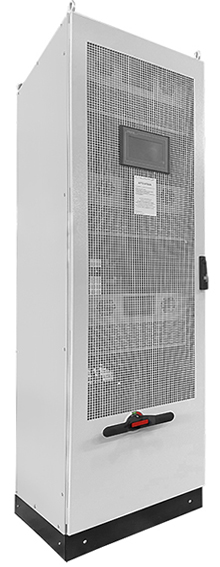AXG, Active Harmonic Filter and Reactive compensation
AXG, Active Harmonic Filter, Reactive compensation, Phase unbalance

The combined systems of the AXG series have a sophisticated power quality control capability.
AXG collects the current trends in real time, sending them
to an internal control circuit, via n. 3 CTs installed on
the loading side.
Through integrated FPGA technology, the fundamental
components of the currents, the harmonic components, the
reactive currents and the components responsible for the
imbalance are extracted; the needed currents for
compensation and the compensation currents emitted by the
AXG system are compared, and the difference is calculated.
In order to allow the IGTB inverter to be able to inject the
necessary currents into the electrical network, input
signals are emitted to the driving circuit, so as to achieve
closed-loop control and complete the compensation function,
both in terms of filtering and of power factor correction.
The operating modes operate according to the priority
principle (selectable), to be chosen between Active Filter
(AHF), Power Factor Correction (PFC) and Phase Balancing
(UNBALANCE).
AHF, Active Harmonic Filter mode
AXG is able to filter harmonic currents (THDi) up to the
50th order and significantly reduce the THDv components.
Applicable in any condition in both the industrial and civil
sectors, they represent the ideal solution for the treatment
of non-linear three-phase loads, with or without neutral.
PFC, Power Factor Correction mode
AXG, thanks to its electronic operation, is able to operate
where a traditional power factor correction system could not
do the same with the appropriate reliability over time.
For example, all applications - mainly in heavy industries -
with prohibitive harmonic contents - both current and
voltage - also for power factor correction systems with
detuning inductors.
How to choose an AXG system
The sizing of an AXG system depends on the purpose of use
(priority) by the customer.
If the objective is the reactive compensation of a system
(or a load), the sizing criteria are the same used for the
calculation of a "traditional" power factor correction
panel; it’s therefore necessary to be aware of the active
power (kW), initial cosphi of the system (or load), voltage
and operating frequency.
If, however, the AXG system must mainly operate as an active
filter, the choice of the system (or load) current to be
filtered is obtained through an appropriate network analysis
in order to extrapolate the sum of the harmonic currents
(not the total current circulating).
If it’s needed to create a "combined system" that includes
both active filter and power factor correction modes, the
total current of AXG will be the sum of the two currents.
For example, on a 400 V 50 Hz network we would have:
- AHF, Active harmonic filter mode 75 A
- PFC, Power Factor correction mode 150 kVAr (216 A)
- Total needed current 291 A
- AXG system’s current, 300 A
Priority of operation
Regardless of the priority set, if the need arises, the AXG
system will still deliver all the current available,
dividing it appropriately according to the needs of the
system, whether they are related to filtering, reactive
compensation and phase balancing.
General features
Quick touch-screen display for viewing network dataCurrent effective values of the load;
- THDi (current harmonic distortion) of the Load;
- Load power factor;
- Active, Reactive, Apparent power required by the load;
- Grid-side current and voltage effective values (after Power Factor Correction/Filtering);
- THDi and THDv (Current and Voltage Distortion) on the grid side;
- Grid side power factor;
- Active, Reactive, Apparent power on the grid side.
- Remote visualization through RS232 and RS485 serial port, Modbus protocol.
- The Currents and Reactive Powers injected by the equipment are also monitored
Applications
- Heavy Industry (Metallurgical, Refineries ...)
- Data Center
- Cement plants
- Paper Mills
- Building Automation Systems
- Automotive Industry
- Waste Treatment Systems